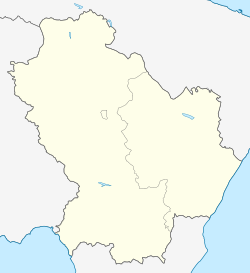Rionero in Vulture
Comune di {{{name}}} | |
|---|---|
| Coordinates: 40°55′N 15°40′E / 40.917°N 15.667°E | |
| Country | Italy |
| Region | Basilicata |
| Province | Potenza (PZ) |
| Frazioni | Monticchio, Monticchio Bagni, Monticchio Laghi, Valico 113 di Monticchio |
| Government | |
| • Mayor | Antonio PLACIDO |
| Area | |
• Total | 53.52 km2 (20.66 sq mi) |
| Population (2018-01-01)[2] | |
• Total | 13,236 |
| Demonym | Rioneresi |
| Time zone | UTC+1 (CET) |
| • Summer (DST) | UTC+2 (CEST) |
| Postal code | 85028 |
| Dialing code | 0972 |
| Patron saint | St. Mark |
| Saint day | April 25 |
| Website | www.comune.rioneroinvulture.pz.it |
Rionero in Vulture is a town and comune in the province of Potenza, in the Southern Italian region of Basilicata. It is bounded by the comuni of Aquilonia (AV), Atella, Barile, Calitri (AV), Melfi, Rapolla, Ripacandida, Ruvo del Monte.
Geography and Climate
Rionero in Vulture is located on the slopes of Monte Vulture in the northern part of the region of Basilicata.
History
The first historical mention of the hamlet of "Saint Maria di Rivonigro" goes back to 1152, when it is mentioned as a feudal possession of the bishop of Rapolla. In 1316 the inhabitants of Rionero abandoned their hamlet and took part in the construction of the village of Atella which had received tax concessions. The hamlet remained unpopulated during most of the 14th and 15th centuries until the influx of refugees from Albania and Greece (i.e. from Scutari and Corona) and several groups taking advantage of tax exemptions promulgated in those years. Its history overlaps with those of the neighbors Barile, Melfi, Ginestra ("Lombarda Massa") and Maschito.
On April 1, 1502 Louis d'Armagnac, Duke of Nemours & Gonzalo Fernández de Córdoba met at the Church of St. Antonio Abate in Rionero to negotiate the partition of Southern Italy. They decided that the Abruzzi and Campania were to go to the French and Apulia and Calabria to the Spanish.
In 1627 the inhabitants of Rionero were forced to change their religious observances from the Greek rite to the Latin rite by Diodato Scaglia, the Bishop of Melfi.
Seriously hit by the earthquake of 1694, Rionero's population in that period did not exceed the 700 souls. Later on the Caracciolo, princes of Torella, to whom belonged the feudal rights, granted permission for the deforestation, the tillage, and the cultivation of lands occupied from the forests of the locality "Gaudo" and as a result of the consequent economic development the population endured a strong growth: in the year 1735 the inhabitants had grown to approximately 3,000, in 1752 to approximately 9,000 and by 1811 they had exceeded 11,000. In this year, on May 4th, the ancient hamlet obtained the administrative autonomy as a comune from King Joachim Murat. By the mid 19th century the population grew until reaching approximately 20,000 inhabitants. The successive and periodic waves of emigration diminished the population down to roughly 14,000 inhabitants.
On September 24, 1943, sixteen Rioneresi were massacred in the Largo San Antonio by German soldiers. Two days later, on September 26, 1943 troops from the 1st Canadian Infantry Division enter Rionero and the neighboring town of Barile unopposed.
Sport
The principal sport of the city is soccer.
- ^ "Superficie di Comuni Province e Regioni italiane al 9 ottobre 2011". Italian National Institute of Statistics. Retrieved 16 March 2019.
- ^ "Popolazione Residente al 1° Gennaio 2018". Italian National Institute of Statistics. Retrieved 16 March 2019.



